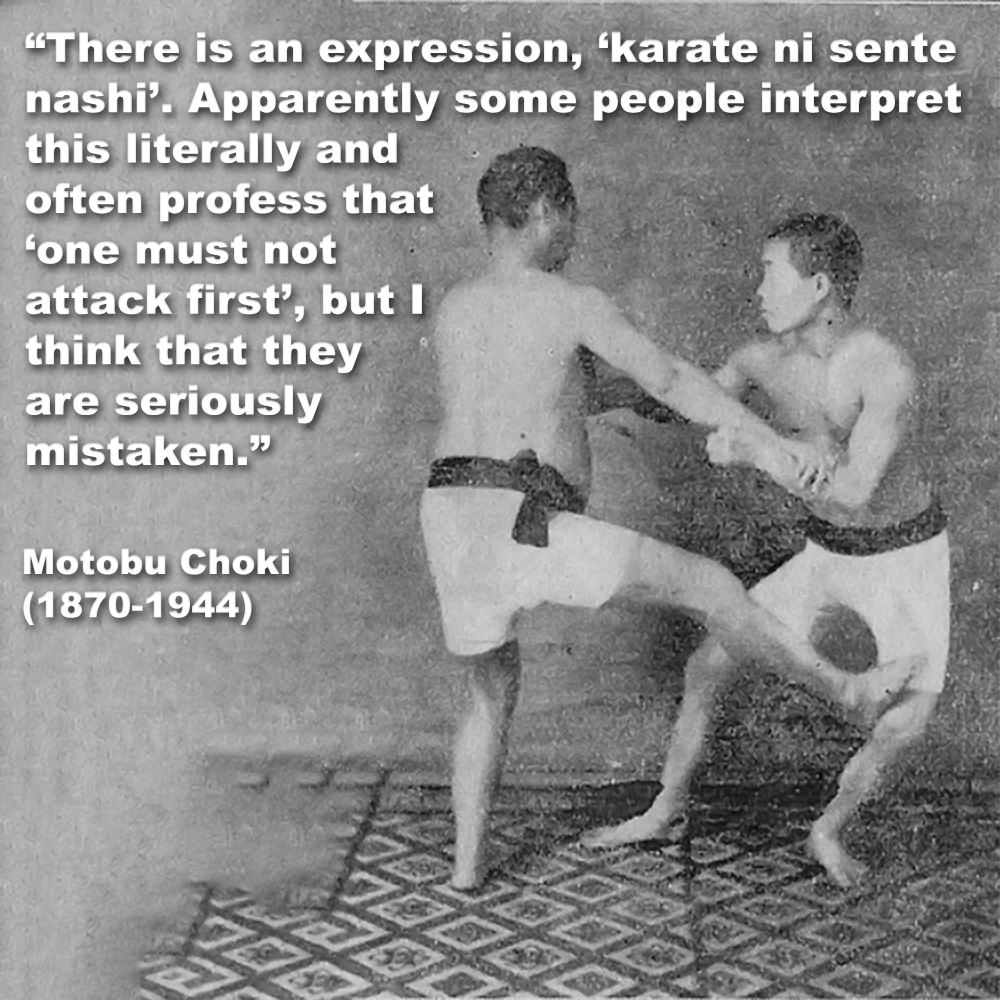
The phrase “Karate ni sente nashi,” (空手に先手なし) often translated as “there is no first attack in karate,” has resonated with karate-ka for generations.
.
Funakoshi Gichin made this principle the second of his “Niju Kun” (二十訓) (Twenty Precepts), reminding us that “karate begins and ends with courtesy”.
.
However, clinging to a literal interpretation can lead to a misunderstanding of this profound principle. To truly understand, we must move beyond the simplistic notion of karate as purely defensive, and acknowledge the reality of combat.
.
While the phrase undoubtedly emphasizes the importance of self-defense, it doesn’t advocate passive acceptance of aggression.
.
“Karate ni sente nashi” isn’t about avoiding action, it’s about being smart about stopping fights before they start.
.
But at its core, “karate ni sente nashi” serves as a guiding principle for ethical behavior. It emphasizes restraint and should discourage you from being the aggressor, reminding practitioners that their skills are for defense, not offense.
.
This commitment to non-aggression fosters a sense of responsibility and discourages the misuse of martial expertise.
.
Secondly, I believe, ”karate ni sente nashi” emphasizes strategic initiative. It doesn’t prohibit initiating action, but rather encourages you to do so in a measured and calculated way.
.
The key lies in understanding the difference between initiating aggression and seizing the initiative.
.
A preemptive strike motivated by fear or anger is aggression, while a strategically timed counter-attack to neutralize an imminent threat is taking the initiative.
.
The concept of “sente” (先手) (initiative) is deeply ingrained in traditional karate practice.
.
Mastering principles like “sen no sen” (先の先) (taking the initiative at the precise moment the opponent starts to move) and “go no sen” (後の先) (reacting and adapting to the opponent’s initiative) and “sen sen no sen” (先先の先) (seizing the initiative by preemptively responding to an opponent’s intentions before they fully materialize) are cornerstones of effective combat.
.
These principles rely on the ability to read the opponent’s intent and respond with decisive action, not on passively waiting for someone to attack.
.
Motobu Choki, in his 1932 publication ‘Watashi no karate-jutsu’ wrote; “There is an expression, ‘karate ni sente nashi’. Apparently some people interpret this literally and often profess that ‘one must not attack first’, but I think that they are seriously mistaken. […]”
.
In my opinion, for what it’s worth, reducing “karate ni sente nashi” to a purely defensive principle ignores the dynamic nature of real-world conflict.
.
In the face of a determined attacker, waiting for the first blow might prove fatal.
.
Often, the opening motions of kata, while categorized as ‘uke’ (meaning ‘to receive’), go beyond simple ‘blocking’, hinting at preemption and strategic positioning. These actions are more than passive defenses. They’re dynamic, and proactive, preparing for, and potentially even deterring an attack before it becomes fully committed.
.
These opening moves can be seen as preemptive measures, rather than simply waiting for the opponent to attack, so that you can act decisively when necessary, whether defensively or proactively.
.
“Karate ni sente nashi” isn’t about being inactive or waiting to be attacked before responding; it’s a call for mindful and responsible action when the situation requires it.
.
.
